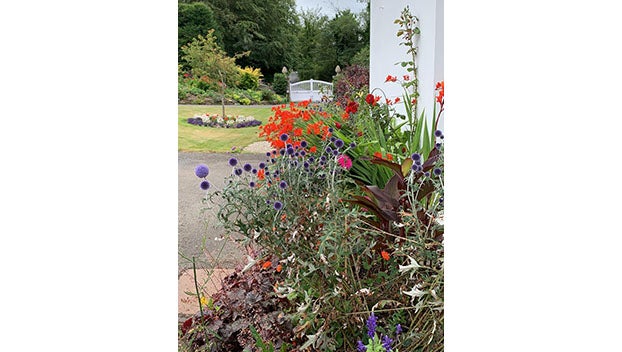Through The Garden Gate: A look through other people’s gardens
Published 12:13 pm Thursday, September 21, 2023

- This garden has an amazing mix of trees, shrubs, and perennials providing interest all year. It’s an envy-inducing garden that looks totally unplanned, but isn’t.
|
Getting your Trinity Audio player ready...
|
Curiosity killed the cat! Cats are, indeed, known for being curious and for getting into trouble because of their curiosity.
I suspect that gardeners are equally curious and capable of getting into trouble. Two weeks ago, I found a strange man leaning over the stone wall around the front of my property taking photos. Technically, he wasn’t in my yard, but he was leaning so far in that a minor slip would have landed him on the wrong side of the wall and in my garden. He mumbled something about encouraging his daughter to love plants and fled. Three days later, he was back.
Not long after that incident, strangers knocked on the door and wanted to know where the elephant ears were planted this year. They couldn’t find them, even though they’ve always been in the right front corner of the yard (There haven’t been any for several years, not since two neighbors had a huge fight over how to care for the elephant ears I had given them.). Someone else wanted to know why I was growing marijuana in a flower bed along the front porch. Sigh. Not weed, but okra and cleomes, which I admit have a distinctive scent.
Yes, we gardeners are an inquisitive lot, and we are definitely intrigued by other people’s gardens. Idle curiosity? Yes, but also a desire to learn, maybe even see that a compatriot is struggling with the same problem. It’s a relief to know that you’re not the only person who can’t get dahlias to bloom all summer.
Visits to other people’s gardens are an opportunity to commune with like-minded souls. They’re also an incredible gift of time, knowledge, and even plants. Some of my favorite plants came from other people’s gardens. My Lilium formosanum came from the garden of a friend and plant whisperer who can grow anything and always has interesting plants that aren’t likely to be found at a local nursery. My much-treasured calycanthus or sweetshrub was given to me by another friend who was afraid that she would kill it.
Visits to other people’s gardens mean learning about new ways of doing things. Several years ago, I was invited to visit a famous garden designer’s property, which he described as “a 10-acre pleasure ground.” I was expecting elaborate, high maintenance swaths of plants, carefully clipped hedges, and serious art. Instead, I found natural, informal groupings of plants – lots of Virginia bluebells, ferns, and hellebores along a stream, bog plants growing in old tubs, groups of spring-flowering bulbs everywhere, and multi-colored wine bottles used to border flower beds near the garage. Weathered stone orbs placed on the trunk of a fallen tree magically became art. Although the design may sound random, everything was united by the repeated use of circular spaces and the color blue. The circles were very unexpected and effective.
The owner of the garden spent hours answering questions about where to source unusual plants, how he had built his deer fence, and much more. He was amazingly patient and generous with his time and knowledge. I suspect that most of us left with our heads bursting with new ideas.
It’s incredibly generous to share a much-loved garden with strangers. It also takes tremendous courage and confidence. I’m not sure I’ll ever be as generous or patient as the garden designer, but I know I should try. I owe him and many other generous gardeners a debt of gratitude.
Come visit; see my weeds and the ramshackle fences designed to deter crazy German shepherds. Do you need some odd, late-blooming native plants or a tough daylily? How about a cutting from my calycanthus? Just let me know. I’m always willing to share. In return, tell me about what you’re doing in your garden.
Dr. Cynthia Wood is a master gardener. Her email address is cynthia.crewe23930@gmail.com.




